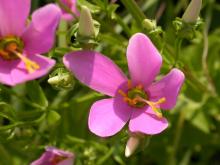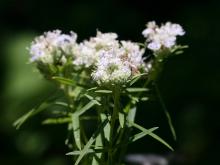Wildflowers, Grasses and Other Nonwoody Plants
Media

Species Types
Scientific Name
Lamium purpureum
Description
Dead nettle, like its close relative henbit, is a common, weedy mint that, in early spring, can carpet wide patches of disturbed ground. Recognize dead nettle by the pyramidal look of its purple- or blue-tinted foliage.
Media

Species Types
Scientific Name
Lamium amplexicaule
Description
In early spring, henbit carpets entire fields with the pinkish-purple of its small flowers. This nonnative mint spreads abundantly but causes few problems. It has shallow roots and fades before crops begin to grow.
Media

Species Types
Scientific Name
Sabatia angularis
Description
Rose-pink, or rose gentian, is a delicately scented native wildflower with floral clusters resembling candelabras. It has square stems and clasping leaves. It is common in open Ozark woods and fields and blooms June–September.
Media

Species Types
Scientific Name
Cunila origanoides
Description
Sometimes called wild oregano, dittany, like true oregano, is a member of the mint family and can be used as a culinary herb and in teas. Look for it on dry, wooded slopes in Ozark counties.
Media

Species Types
Scientific Name
Blephilia ciliata
Description
Square, unbranching stems, opposite leaves, two-lipped flowers, and a mild minty fragrance are clues Ohio horsemint is in the mint family. Tight, rounded flower clusters are stacked atop one another at the stem tips.
Media

Species Types
Scientific Name
Prunella vulgaris
Description
A square-stemmed plant with opposite leaves, self-heal bears two-lipped blue, lavender, or violet flowers in a cylindrical head. We have two varieties of self-heal in Missouri, one native and one introduced.
Media

Species Types
Scientific Name
Scutellaria incana
Description
Showy clusters of blue-violet, two-lipped flowers adorn downy skullcap. This native mint is found mostly in the southern half of the state.
Media

Species Types
Scientific Name
Valerianella radiata
Description
At first glance, you might overlook corn salad, except for the large colonies it often forms. The young leaves can be eaten as a salad green, hence the name.
Media

Species Types
Scientific Name
Mirabilis nyctaginea
Description
Wild four-o’clock grows in fields, prairies, waste places, roadways, and railroads, often in poor soils. It’s called “four-o’clock,” because the magenta flowers don’t open until late afternoon.
Media

Species Types
Scientific Name
Pycnanthemum tenuifolium
Description
Slender mountain mint has smooth, square stems, opposite, narrow leaves, and dense heads of 2-lipped white (or lavender) flowers. Aromatic and minty, it can be grown at home in the herb garden, and its leaves used for seasoning food.
See Also
About Wildflowers, Grasses and Other Nonwoody Plants in Missouri
A very simple way of thinking about the green world is to divide the vascular plants into two groups: woody and nonwoody (or herbaceous). But this is an artificial division; many plant families include some species that are woody and some that are not. The diversity of nonwoody vascular plants is staggering! Think of all the ferns, grasses, sedges, lilies, peas, sunflowers, nightshades, milkweeds, mustards, mints, and mallows — weeds and wildflowers — and many more!





















